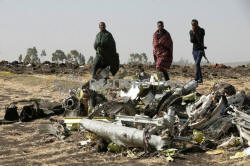How excess speed, hasty commands and flawed software
doomed an Ethiopian Airlines 737 MAX
 Send a link to a friend
Send a link to a friend
 [April 05, 2019]
By Tim Hepher, Eric M. Johnson and Jamie Freed [April 05, 2019]
By Tim Hepher, Eric M. Johnson and Jamie Freed
PARIS/SEATTLE/SINGAPORE (Reuters) - Minutes
after take-off, the pilots of an Ethiopian Airlines 737 MAX were caught
in a bad situation.
A key sensor had been wrecked, possibly by a bird strike. As soon as
they retracted the landing gear, flaps and slats, it began to feed
faulty data into the Maneuvering Characteristics Augmentation System (MCAS),
designed to prevent stalls.
Flying faster than recommended, the crew struggled with MCAS. But the
high speed made it nearly impossible to use the controls to pull the
nose up.
Moments later, the Boeing Co jet hit the ground, killing all 157 people
onboard after six minutes of flight.
Ethiopian authorities said on Thursday that the pilots followed all the
correct procedures in trying to keep MCAS from sending the plane into a
fatal dive.
But the full picture of what happened in the cockpit of Flight 302 on
March 10 is emerging from a preliminary report and a newly released data
plot showing how crew and technology interacted.

The airline's youngest-ever captain, a 29-year-old with an impressive
8,100 hours flying time, and his rookie 25-year-old co-pilot may have
made a crucial mistake by leaving the engines at full take-off power,
according to data and other pilots.
By the end, the aircraft was traveling at 500 knots (575 mph, 926 kph),
far beyond its design limits.
That and some other potential missteps may have left them unable to
fight flawed Boeing software that eventually sent the jet into an
uncontrollable dive, experts said after studying the data.
"Power being left in take-off power while leveling off at that speed is
not a normal procedure," said one U.S. pilot, who declined to be named
because he was not authorized to speak to the media. "I can't imagine a
scenario where you'd need to do that."
The Ethiopian Airlines crash, and another in Indonesia five months
earlier, have left the world's largest planemaker in crisis as its
top-selling jetliner is grounded worldwide, and Ethiopia scrambling to
protect one of Africa's most successful companies.
Boeing is working on a software fix for MCAS and extra pilot training,
which its chief executive, Dennis Muilenburg, said would prevent similar
events from happening again.
BIRD STRIKE
Sources who reviewed the crash data said the problems started barely 12
seconds after take-off.
A sudden data spike suggests a bird hit the plane as it was taking off
and sheared away a vital airflow sensor.
As with the Lion Air crash in Indonesia, the damaged 'angle of attack'
sensor, which tells pilots what angle the aircraft has relative to its
forward movement, may have set off a volatile chain of events.

In both cases, the faulty sensor tricked the plane's computer into
thinking the nose was too high and the aircraft was about to stall, or
lose lift. The anti-stall MCAS software then pushed the nose down
forcefully with the aircraft's "trim" system, normally used to maintain
level flight.
The first time the MCAS software kicked in, the Ethiopian Airlines
pilots quickly countered the movement by flicking switches under their
thumbs - they had recognized the movements as the same type all flight
crews had been warned about after the Lion Air flight.
But data suggest they did not hold the buttons down long enough to fully
counteract the computer's movements. At that point, they were a mere
3,000 feet above the airport, so low that a new warning - a computerized
voice saying "don't sink" - sounded in the cabin.
When MCAS triggered again, the jetliner's trim was set to push the nose
down at almost the maximum level, while the control yoke noisily
vibrated with another stall warning called a "stick shaker."
[to top of second column] |

Ethiopian police officers walk past the debris of the Ethiopian
Airlines Flight ET 302 plane crash, near the town of Bishoftu, near
Addis Ababa, Ethiopia March 12, 2019. REUTERS/Baz Ratner/File Photo

This time, the pilots countered MCAS more effectively. But when they turned off
the system - as they were instructed to do by Boeing and the U.S. Federal
Aviation Administration (FAA) in the wake of the Lion Air disaster - the nose
was still pointed downward, leaving the jetliner vulnerable.
The combination of excess speed and cutting off the system while the plane was
still leaning downwards meant up to 50 pounds of force would be needed to move
the control column, and moving the manual trim wheels was impossible.
'PULL UP, PULL UP'
The captain called out "pull up" three times. The co-pilot reported problems to
air traffic control.
In the meantime, the aircraft's speed remained abnormally high.
The bird strike and loss of airflow data would have affected airspeed
information too. In such cases, pilots know to turn off automatic engine
settlings and control thrust manually.
But the report says "the throttles did not move," without elaborating. Data
confirms the engines stayed at nearly full power. Other 737 pilots say that made
the crew's job tougher by making the controls much harder to move.
Some experienced pilots said there were an array of stressful factors sapping
the pilots' attention, which Muilenburg addressed on Thursday.
"As pilots have told us, erroneous activation of the MCAS function can add to
what is already a high-workload environment," Muilenburg said. "It's our
responsibility to eliminate this risk. We own it and we know how to do it."

Among the distractions was a "clacker" warning telling the pilots their aircraft
was going too fast.
As the nose gradually fell, the pilots turned to a last-resort device to adjust
the plane's trim.
The captain asked the young co-pilot to try to trim the plane manually using a
wheel in the center console to lift the nose and make it easier to recover from
the dive.
But it was too hard to move the wheel. Both men then tried to pitch the nose up
together. The captain, according to the report, said it was not enough.
MCAS RE-ACTIVATES
In a possible last-ditch attempt to level the plane, data suggests the pilots
turned MCAS-related systems back on. That would also reactivate the electric
trim system, and perhaps make it easier for the pilots to force the reluctant
nose higher.
Reactivating MCAS is contrary to advice issued by Boeing and the U.S. Federal
Aviation Administration after Lion Air. The report did not address that.
The pilots managed to lift the nose slightly using the electric thumb switches
on their control yokes. But data suggest they may have flicked the switches too
gingerly.
With its power restored, a final MCAS nose-down command kicked in, eventually
pushing the nose down to a 40 degree angle at an airspeed of up to 500 knots,
far beyond the plane's operating limits.
As the 737 MAX plunged, G-forces turned negative, pulling occupants out of their
seats and possibly inducing a feeling of weightlessness as the plane hurtled
toward the ground.
Just six minutes after take off, the plane crashed into a field.
(Additional reporting by Jason Neely in Addis Ababa, Tracy Rucinski in Chicago,
David Shepardson in Washington, Allison Lampert in Montreal; Editing by Gerry
Doyle)
[© 2019 Thomson Reuters. All rights
reserved.] Copyright 2019 Reuters. All rights reserved. This material may not be published,
broadcast, rewritten or redistributed.
Thompson Reuters is solely responsible for this content. |